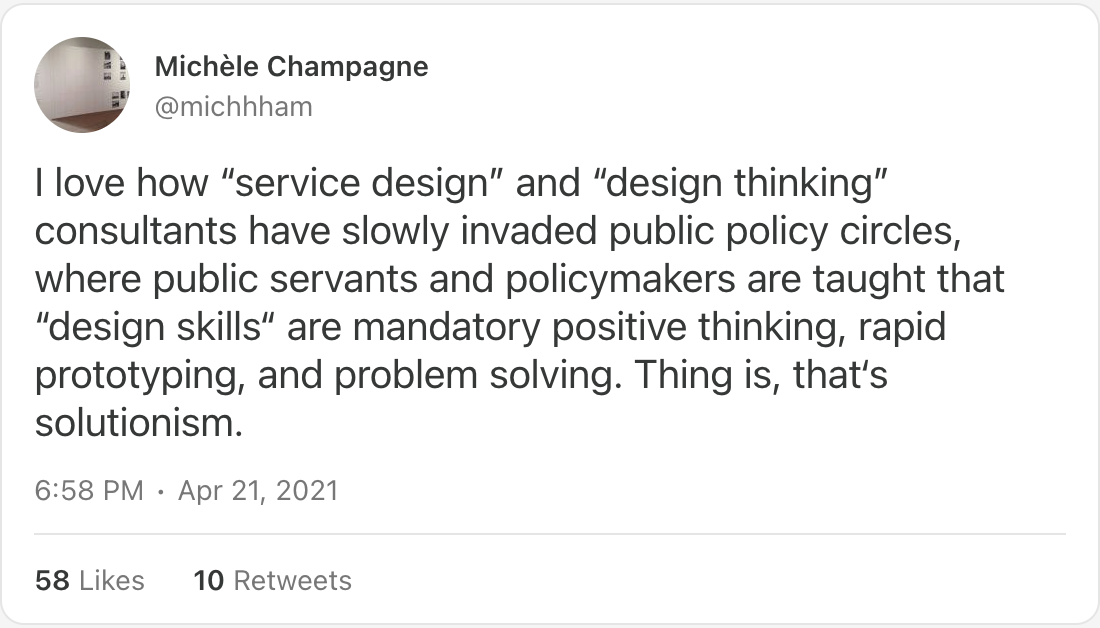The limits of "Customer Service" and "Administrative Burden" frameworks.
The limits of "Customer Service" and "Administrative Burden" frameworks.
In All About Love, bell hooks said “definitions are vital starting points for the imagination. What we cannot imagine cannot come into being. A good definition marks our starting point and lets us know where we want to end up.” I suppose the inverse of this is that a bad definition can stifle the imagination or lead us to a dead-end. In this spirit, this issue examines what civic tech loses when it leads with the concepts of “customer service” and “administrative burden” and not larger political goals. This issue invites the reader to put limiting concepts in their place, imagine wildly, and hold out for something better.
I. “Customer” Diminishes Our Democratic Role
On December 13th, the Biden Administration published an Executive Order on Transforming Federal Customer Experience and Service Delivery to Rebuild Trust in Government. The EO promises to improve a slew of government services with the help of technology and rests on a theory of change that these “customer service” improvements will “engender trust,” but does not speak to changing the substance of these public goods — which may be the primary cause of the public’s trust issues — only their delivery. While the EO harkens to democratic principles, it makes no mention of how public input informed why they were prioritizing the delivery of the services mentioned versus other services.
Words are imbued with meaning and connotation and using “customer service” to describe the delivery of public goods has a dark side. It’s not just that the analogy doesn’t logically work — everything that makes “customer service” high quality in the business context is missing from government, there is no competition forcing the government to attract and retain customers — this phrase will not get us there. It’s that this mismatch of power dynamics makes it a dangerous phrase to substitute in. Calling the public “customers” implicitly reduces their participatory power to mere consumers and doesn’t fully embody the government’s duty to serve all its people well.

It’s important in these times of diminished voter rights, rising police surveillance, and prosecution of protestors to protect our democratic rights and be wary of anyone co-opting democratic language for lesser rights. As illustrated by Michèle Champagne’s brilliant tweet (above), asking for feedback after the bulk of the substance has been decided isn’t democratic, it’s providing a very small set of choices and dressing it up as democratic.
Let’s move away from consumer language for public goods to participatory and rights-based language; let’s lead delivery improvement initiatives with public input and place these improvements in the service of larger debates about what collective goods we want to have as a community. For example, if 63% of the population is supportive of healthcare for all, let’s be sure related public service improvements contemplate and serve that substantive expansion; investing in more application infrastructure might make less sense than considering how technology can support the issuance of universal medicare cards or uniform reporting standards. This is a job the Executive Branch could spearhead (the Federal Government takes on pilot projects routinely with input from the public), but it is also one the larger civic tech community should hold in their minds as a possibility.
II. Friction Is Political
As part of Civic Tech Book Club, we discussed Administrative Burdens in the time of COVID-19, a webinar with Pamela Herd and Donald Moynihan, who co-authored a book by the same name. In the book and talk, Pamela and Donald describe a cogent framework of administrative burdens and three sets of costs: 1. learning costs, 2. compliance costs, and 3. psychological costs, as well as ways to evaluate and shift these costs back to the state. The goal of the framework was to capture and define many sets of friction the public faces when interacting with the state and I think this framework does a great job of giving names to these types of issues. The book club also chatted about how this framework might be operationalized in a technology context and noted how there was much overlap (but also some differences) with Code for America’s Social Safety Net Scorecard as a potential starting point.
The conversation I had with the book club helped me orient administrative burden as a subset of issues people should consider when evaluating public goods, but one that is insufficient by itself and potentially detrimental if taken by itself. I worry technologists may be tempted to overly fixate on administrative burden issues (versus other issues in the larger universe of civic issues) because of technology’s innate friction-reducing abilities through automation and standardization. Just because technology can address a subset of issues, it doesn’t mean it’s not creating new issues or isn’t counterproductive to addressing the root causes that cause programs to be unsatisfactory or unequally burdensome.
How friction is imposed is political, but to simply be anti-friction by itself without additional context is suspiciously apolitical. Also, reducing friction may overlook the political reasons it was created in the first place and essentially temporarily treat the symptom without addressing the underlying condition. In terms of politics, we discussed how underlying values of deservedness and public investment support these burdens and how reducing friction can create new harms:
- Deservedness. According to a sociological study that aimed to quantify this concept, there are five measurable deservedness criteria – Control, Attitude, Reciprocity, Identity, and Need (or CARIN) that demonstrate popular support for social policies. This study, for example, identified the elderly as deserving and the unemployed as undeserving (according to popular opinion and the heuristic), which could provide some explanation for why the administrative burden for social security is far less than unemployment. These political issues are core to addressing these burdens, with technology improvements always being marginal and beholden to them.
- Public investment. If you just looked at these administrative burden texts in a vacuum, you might assume forms are a necessary evil and be quite surprised to learn that other countries don’t have these forms at all and do taxes for their people or provide benefits proactively right now. The book club reflected that even if there was political will to remove these forms (which there is not), the state doesn’t have the capacity (data, personnel, or otherwise) to currently take on these burdens without more resources. It’s been demonstrated larger governments (per capita) provide higher-quality services, which may be the best way to improve delivery. Technology fixes, with their promise to do more for less, may effectively run counter to arguments for much-needed investment.
- Friction as protection. How we reduce friction is political too and contextual. An administrative burden framework focused primarily on friction may miss the privacy or discriminatory harms caused by the IRS’ recent use of facial recognition technology for tax forms, which has since been revoked after public outcry. Countries that do not have forms (as mentioned above) have different instances of discrimination and surveillance that may make such advances in the United States not possible. Some frictions may be better than their alternatives, so we must be sure to include the bigger picture in our civic dreams.
We should consider how administrative burden analyses, like the Code for America’s Social Safety Net Scorecard and the Administrative Burden book, can bolster arguments for public investment, and new senses of deservedness, and keep a watchful eye for how and where friction is our friend.
III. Imagining Something Better
To some extent, the above frameworks represent the limits of what technology can offer when used simply as a tool for efficiency. For tech to be truly civic it must be actively engaged in the public’s politics which rarely supports simply turbocharging the status quo. Excerpts from three great reads below offer us ways to imagine using technology (1) strategically for systematic change, (2) to better understand and discuss our social problems, and (3) to inspire us to abandon old systems altogether.
Marginal Changes Arrayed and Coordinated for Systemic Change
In September 2014, Emily Shaw, after attending a Code for America summit, generously wrote about how the civic tech community lacked a solidified political ethos and how smaller “civic tech” efficiencies could be strategically directed toward larger political goals. She illustrates this point beautifully with an example of a “civic tech” response to the Black Lives Matter protests that came up at the conference:
At the summit, the solution that was discussed in connection with the Ferguson case was a messaging app that reminded you to attend your court date and to encourage you to pay your fine online.
This is the kind of approach that aims to create small change at the margin rather than addressing deeper, causal issues. It does nothing to address the problem of whether it was appropriate for those citations to be issued in the first place. It does nothing to address the racial tension that leads police to spiral so quickly into escalation. It doesn’t inquire into the nature of civilian oversight over police behavior, it fails to involve municipal funding conditions that lead police to rely on fines as a revenue stream, and it does not increase avenues for appeal and feedback from the public.
This is certainly not to dispute the fact that people should be able to pay their fines and citations online. They absolutely should; making it easier for them to do so is a positive social contribution and a genuine improvement. It’s just to say that this is in no way enough of an improvement given the scale of the problem, and it should be widely understood that this is not the place where civic tech stops.
Rather, civic tech solutions must come to be characterized by marginal changes that are arrayed and coordinated in such a way that they help effect systemic change.
When the civic tech community is working on marginal changes is it with political groups for larger systemic strategies?
Bolstering Social Change Arguments with Deeper Understanding
In Roles for Computing in Social Change, another book club read, the authors acknowledge that “realizing principles of justice and equity requires addressing the root social, economic, and political origins…not optimizing around them” and suggest four possible roles for computing to do that isn’t optimizing at all. They suggest computing can serve social change as a:
Diagnostic, helping us to understand and measure social problems with precision and clarity;A formalizer, computing shapes how social problems are explicitly defined — changing how those problems, and possible responses to them, are understood;A rebuttal when it illuminates the boundaries of what is possible through technical means; and asA synecdoche when it makes long-standing social problems newly salient in the public eye.
These suggestions all revolve around technology as a tool for understanding our social problems better and providing richer fodder for greater democratic dialogue.
Reconstructing Systems Entirely
In Credit Scoring and the Risk of Inclusion, Tamara K. Nopper completes her essay on the many issues and possible solutions with credit scoring with:
Finally, there is also another possibility to consider, which is the elimination of the credit scoring system altogether … We spend a lot of time and energy trying to figure out how to get people scored rather than on reconstructing our economic system to be more equitable and not rely on the datafication and scoring of our socioeconomic activity.
For me, this option to abandon a system rather than optimize it should be included in any evaluation. This, like the rebuttal option for computing above, or abolitionist stances, reminds us that nothing at all is always an option and it might be the boldest reimagining possible.
I know folks who are drawn to civic technology want to work on projects for the common good and are endlessly curious. I hope the above inspires folks to think about transactional improvements as a very small thing in the universe of things that technology can do for civics.

